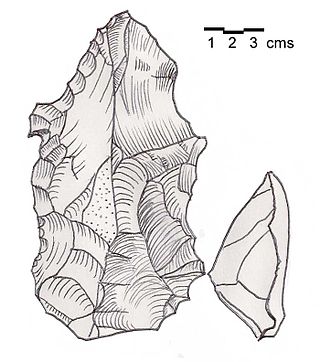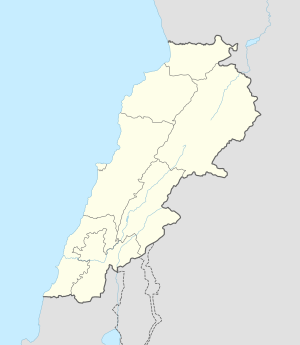
Hermel is a town in Baalbek-Hermel Governorate, Lebanon. It is the capital of Hermel District. Hermel is home to a Lebanese Red Cross First Aid Center. Hermel's inhabitants are predominantly Shia Muslims.

Qaa, El Qaa, Al Qaa, Qaa Baalbek or Masharih al-Qaa is a town in Baalbek-Hermel Governorate, Lebanon. A 2010 report stated that population of the settlement was 500, all Lebanese Maronites

Joub Jannine is located in the Beqaa Valley in Lebanon.

Rayaq - Haouch Hala, also romanized Rayak, is a Lebanese town in the Beqaa Governorate near the city of Zahlé. In the early 20th century and up to 1975 and the outbreak of the civil war, it was Lebanon's most important railway center, where the 1.05-m Beirut–Damascus line met the standard-gauge line north to Baalbek, Homs, and Aleppo. It now has an air base and a hospital. Rayak Air Base was bombed by the Israeli Air Force during the 2006 Lebanon War. The landing strip was severely damaged as a result.

Duris is a village located approximately 3 km (2 mi). southwest of Baalbek in the Bekaa Valley, Lebanon. It is the site of a 13th-century Muslim shrine and a necropolis from the late Roman Imperial period that is currently undergoing archaeological investigation.

Kaukaba, Kaukabet El-Arab or Kaukaba Station is a village in the Hasbaya District in the Nabatiye Governorate in southern Lebanon.

Archaeology of Lebanon includes thousands of years of history ranging from Lower Palaeolithic, Phoenician, Roman, Arab, Ottoman, and Crusades periods.

Qaraoun is a Lebanese village, 85 km from Beirut, known for its Lake Qaraoun in the Beqaa Valley formed by the El Wauroun Dam built in 1959. It is an ecologically fragile zone in the Western Beqaa District. The village lies about 800 m above sea level. The dam is located nearby on the Litani River.

Heavy Neolithic is a style of large stone and flint tools associated primarily with the Qaraoun culture in the Beqaa Valley, Lebanon, dating to the Epipaleolithic or early Pre-Pottery Neolithic at the end of the Stone Age. The type site for the Qaraoun culture is Qaraoun II.

Trihedral Neolithic is a name given by archaeologists to a style of striking spheroid and trihedral flint tools from the archaeological site of Joub Jannine II in the Beqaa Valley, Lebanon. The style appears to represent a highly specialized Neolithic industry. Little comment has been made of this industry.

The Qaraoun culture is a culture of the Lebanese Stone Age around Qaraoun in the Beqaa Valley. The Gigantolithic or Heavy Neolithic flint tool industry of this culture was recognized as a particular Neolithic variant of the Lebanese highlands by Henri Fleisch, who collected over one hundred flint tools within two hours on 2 September 1954 from the site. Fleisch discussed the discoveries with Alfred Rust and Dorothy Garrod, who confirmed the culture to have Neolithic elements. Garrod said that the Qaraoun culture "in the absence of all stratigraphical evidence may be regarded as mesolithic or proto-neolithic"..
Jebel Aabeby is an archaeological site approximately 2 kilometres (1.2 mi) southeast of Sidon, to the west of the road north to Qraye in Lebanon. The site is on a hill where a number of Cedar trees surround the Mar Elias monastery on the western side of the summit. A Heavy Neolithic assemblage of flint tools made by the Qaraoun culture was collected from some Olive terraces bordering on the road and from an area above them that was disturbed in the construction of a trackway. The flint was of a brown, Nummulitic, Eocene type, some having been patinated to white while others were found fresh. Several broad blades were found along with heavy scrapers on flakes, massive cores, rabots, racloirs and a few smaller scrapers. The material now stored in the Museum of Lebanese Prehistory was studied by Henri Fleisch, who concluded that the site was likely used as a prehistoric factory.
Ourrouar is a series of archaeological sites approximately 8.5 kilometres (5.3 mi) south southeast of Beirut, Lebanon. It is near Hadeth south on the north side of the Nahr Ghedir.

Baidar ech Chamout, Baïdar ech Chamoût or Beidar Chamout is a small village located 3 kilometres (1.9 mi) northeast of Machgara in the Western Beqaa District of Beqaa Governorate in Lebanon.

Wadi Yaroun, Wadi Yarun, Wadi Jarun, Wadi Hanine, Jarun or Jareon is a wadi located south of Ain Ebel in the Bint Jbeil District of Nabatieh Governorate in Lebanon. After it reaches Yaroun it is called the Wadi Nahle or Wadi Nalesh and after reaching Debel it is called the Wadi Ayun et Tannour.

Flaoui or Fleywe or Flaoueh is a small village located 17 kilometres (11 mi) northwest of Baalbek, Lebanon in Baalbek District, Baalbek-Hermel Governorate, Lebanon. It is located near the north–south road that runs from Bodai to Chlifa.

Maqne or Maakne is a town and municipality in Baalbek District, Baalbek-Hermel Governorate, Lebanon.

Qalaat Tannour is a Shepherd Neolithic archaeological site located halfway between Britel and Haour Taala, 12 kilometres (7.5 mi) southwest of Baalbek in the Baalbek District of the Beqaa Governorate in Lebanon.
Riha Station is a hill with a thin, occupational Shepherd Neolithic archaeological site located between the villages of Chaat and Knaisse, 14 kilometres (8.7 mi) northwest of Baalbek in Lebanon.
Saraain El Faouqa is a village located 6 kilometres (3.7 mi) northeast of Rayak in Baalbek District, Baalbek-Hermel Governorate, Lebanon. Most of its inhabitants Shia Muslims and a minority are Maronites.















